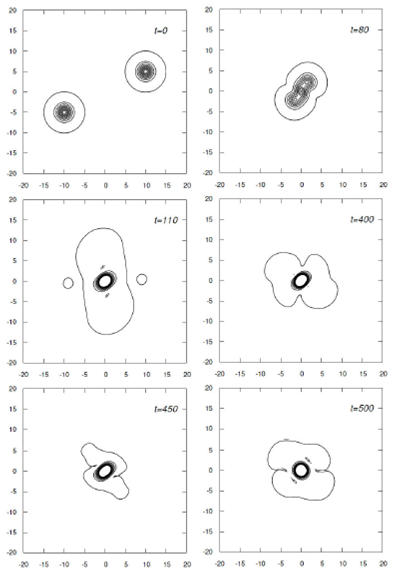1.Introduction
One of the viable dark matter candidates currently under study is the ultralight spin-less boson 1,2, which is attractive because of some interesting properties consistent with observations. For instance when its mass is of order m ∼10-22 eV structures do not develop cusps due to the large de Broglie length 3-6, whereas at large scale the behavior is consistent with that of CDM 7,8. At the same time, this model is also consistent with the small structure abundance of the mass power spectrum 1,2,4,9.
Local scale dynamics on the other hand, should indicate differences between CDM and ultralight bosonic dark matter and impose constraints on the latter. For instance, the relaxation process should be special, being the gravitational cooling process an option 10,11 in which matter carries out kinetic energy, leaving the structure under relaxation in a nearly virialized state, or other processes involving dynamical friction 12, or damping 13 could provide the relaxation mechanism. Also the collisions and interaction between structures can provide important restrictions to the model, for example the density resulting from head-on core mergers 14 that may result in the destruction of luminous matter clusters during the process for certain particular scenarios 15. Other restrictions, such as those on the boson mass are found from the analysis of core oscillations that may or may not allow the formation of star clusters in galaxies 16.
Locally, the dynamics of this dark matter model is ruled by the Gross-Pitaevskii-Poisson (GPP) system, that describes the evolution of a Bose-Einstein Condensate in the Gross-Pitaevskii mean field approximation, contained by the gravitational potential generated by itself. One point the various studies and approaches at local scale of the model have in common, is that this type of dark matter clumps into structures with a universal profile, either into an equilibrium configuration of the GPP system for isolated systems 11,17, or composed of a core, sometimes called solitonic profile that matches the density profile of an equilibrium configuration 7, and a surrounding cloud with a NFW profile obtained from simulations involving structure formation clustering 7,8,12,18-20.
Among the common interactions between structures or cores, the merger of two of them is very important and is the subject of this paper. Configurations resulting from a merger with angular momentum, naturally inherit rotation from the original merging cores. Rotating structures within this dark matter model are interesting for various reasons. One of them is that rotation is an extra parameter for BEC dark matter halos that helps fitting galactic rotation curves by keeping the boson mass unchanged 21,22, and will possibly help to reduce the dispersion of boson mass in rotation curve fitting of big catalogs 23. In a similar context, ellipsoidal analytic solutions to the GPP with rotation have been associated with possible vortex solution 24. And more recently, new exact solutions of the GPP system with rotation are also being constructed with the aim of studying this dark matter model at the local scale 25,26.
The study of core mergers in orbit or during structure formation, within the context of ultralight bosonic dark matter is not new. In fact also multiple soliton mergers have also been studied 12,19,27. Specially in 19, the mergers have been analyzed in detail, from the initial conditions to the properties of the final configuration. Among the most interesting results, it was found that the final mass of the merger does not depend on the initial momentum of the orbiting objects and only depends on mass ratio, the total initial mass, and the total energy of the system. Also in 18, the density of cores resulting from mergers is compared with the solitonic profile in the context of structure formation simulations.
The analysis in our paper is very similar to that in 19, however, some new results arise. Important differences are that we solve the GPP system without using the Madelung transformation, not for calculations nor for diagnostics of macroscopic quantities. We in fact confirm that the final mass of the merger does not depend on the initial angular momentum of the pre-merger configuration, however, we find this result holds only for the equal mass case. We also find that the angular momentum of the final configuration depends on the initial conditions prior to merger, for both the equal and unequal mass cases.
On the other hand, in Ref. (6), within the analysis of structure formation, it is found that cores exhibit strong undamped oscillations. Our results are consistent with this evidence. From our analysis, we find that the configuration resulting from the merger of two cores exhibits a dynamical behavior, characterized by oscillations with considerable amplitude that depend on the parameters of the binary system. The final structure does not relax, however by fitting the density profile at different times we illustrate how the core radius and central density change in time.
The paper is written with the following structure. In Sec. 2 we describe the method used to simulate the mergers. In Sec. 3 we analyze the equal and unequal mass scenarios. In Sec. 4 we draw some conclusions.
2.Evolution of the system
Like in the analyses of structure formation and binary mergers mentioned before, we assume the dynamics of the ultralight bosonic dark matter is ruled by the GPP system of equations. Likewise we assume the free field regime, where the self-interaction among bosons is neglected, the so called fuzzy dark matter regime. Finally, we solve the equations using numerical methods and initial conditions described below.
2.1.Numerical methods
We solve the time dependent GPP system of equations which in code units is written as
that describes the evolution of the fuzzy dark matter. Here, Ψ represents the
wave function of the system and
We solve the Gross-Pitaevskii equation numerically in 3D using the method of
lines for the evolution across spatial slices separated by intervals of time Δt.
The spatial domain
We discretize the equations with second order accurate finite difference stencils
for spatial derivatives. For the sake of accuracy in the region of the merger,
we use fixed mesh refinement based on the Berger-Oliger algorithm 28, with concentric refinement
boxes. The resolution factor between successive refinement levels is one half.
Considering that for the stability of the evolution, time and space resolution
are limited by the condition
We solve Poisson equation for V with a Multigrid algorithm with subcycles that use the Successive Over Relaxation method. This equation is solved at initial time and during the evolution. Due to its computational cost, the integration of Poisson equation represents the major bottleneck of the code during the simulations.
Since we want to avoid reflections of matter from the boundary of the numerical
domain, and because the Gravitational Cooling depends on the emission of matter
that carries kinetic energy with it, we implement a sponge consisting of the
addition of an imaginary potential such that
2.2.Initial conditions
We assume the colliding objects are equilibrium configurations, which are
spherical stationary solutions, constructed by assuming a harmonic time
dependence of the wave function
The initial wave function for the collision of two configurations is the
superposition of the wave functions of two of these equilibrium configurations
with different masses and linear momentum. For the superposition we use the
method in 14, specifically, we
do not solve the Sturm-Liouville problem for two equilibrium configurations with
different masses. Instead, we exploit the scale invariance of the GPP system of
equations 29, namely that by
scaling physical quantities as
In practice the typical equilibrium configuration is that with the central value
of the wave function
The second configuration that will collide, is a configuration constructed with
the scaling relations above, represented by the wave function
We then interpolate and superpose the two configurations in the numerical domain D. In order to maintain the system evolving within the numerical domain, we set the center of mass of the configuration at the coordinate origin. We parametrize the initial conditions by fixing the coordinates of the lighter configuration with mass Mλ at (x0, y0,0) with x0,y0 > 0. Then, in order for the center of mass to lie at the origin, the center of the heavy configuration with mass M1 must be centered at coordinates (-λx0, -λy0,0). In this set up y0 will play the role of impact parameter prior to merger.
The angular momentum is added through the imprint of linear momentum to the
configurations along the x direction only. For this, we parametrize the momentum
with the x-component of the heavy configuration with mass M1 that we
set to px0. Then again, in order to keep the center of mass
approximately at the coordinate origin, the momentum of the light configuration
must be
2.3.Diagnostics
We monitor the dynamics of the system by evaluating some macroscopic variables. These include the mass M, kinetic energy K, gravitational energy W and the z component of the angular momentum Lz. These quantities are
where the integrals are calculated using the second order accurate trapezoidal rule. A first important quantity is the total energy E = K + W, whose sign determines when a system is bounded (E < 0) or unbounded (E > 0). A second one is Q = 2K + W which should be zero for a virialized system and allows one to determine when a system is near, tends to or is far from a virialized state.
3.Analysis
3.1.Parameter space
There is a wide variety of possible configurations that can be explored. However, three parameters influence the behavior of the configuration resulting from the interaction between the two cores, namely, the mass ratio MR momentum px0, and impact parameter. These three parameters determine wide ranges of angular momentum and total energy values at initial time. It would be ideal to have the possibility of exploring a wide range of this parameter space. Nevertheless, due to the expensive computational cost of simulations, we restrict the exploration to illustrate the influence of some parameters using specific values.
First, we set two possible values of the mass ratio MR = λ = 0.5,1, which are the equal mass scenario and the two to one mass ratio case, which will illustrate well the behavior of the system in unequal mass encounters.
Second, we consider various values of the impact parameter y0. The radius of the configuration with mass M1 is r95 ∼ 3.93 in code units , whereas that of mass M1/2 is twice as big. Thus we study the range of values y0 = 1,2,…,10 that accounts for scenarios ranging from nearly head-on to a separation various times bigger than the size of the structures.
Third, we distinguish between merger and unbounded scenarios. In the first scenario the two configurations end up together and form a final configuration. In the second scenario, either the configurations flyby each other or behave as solitons. The momentum px0 is useful to generate the two scenarios, because it sets the amount on kinetic energy K of the two configurations together. With a low value of this parameter the gravitational energy W dominates, implying that E < 0, otherwise a high momentum contributes to K that can contribute importantly to the energy to be positive and produce unbounded configurations. The threshold value for the head-on scenario is found to be px0 ∼ 0.7 30 which serves as a guide to avoid non-merging cases.
We empirically found a range of values of px0 for which at initial
time the total energy is negative for the two values of MR and all the values of
y0. Values in the range
The values of these physical parameters suggest the numerical parameters to be
used. The first parameter is the location of the lighter configuration at
(x0, y0,0) with x0 = 10 in all cases. We
use this value because the interference at the origin between ψ1 and
ψA,
3.2.Global quantities
In a merger scenario, the two cores collide and form a single final configuration whose density profile can eventually be fitted with a simple function that can be further used to understand and analyze the physics of different processes.
We study now this scenario using px0 = 0.1 for the two values of MR and all the values of the impact parameter y0. The system of Eq. (1) is solved numerically for the initial conditions described above and we show the evolution of some of the scalars defined in Sec. II.C in Fig. 2, for the ten values of y0 = 1,…,10.

Figure 2 For the case p x0 = 0:1, we show the total energy E, the total mass M and L z for the two mass ratios considered MR = 0:5; 1 and the ten impact parameter values y0 = 0; :::; 10. Labels are used only for the two extreme values of y0 = 1; 10, whereas the unlabeled curves correspond to the other eight intermediate values of y0.
The energy E is shown normalized with the absolute value of its initial value. Notice that the total energy becomes more negative than at initial time, which indicates that the gravitational energy plays a more important role with time. The energy is also lost in a bigger proportion for smaller impact parameter y0, and for MR = 1 than for MR = 0.5.
The mass is normalized with the mass of the standard equilibrium configuration M1, therefore for MR = 1 the total mass is initially M = 2, whereas for MR = 0.5 the initial mass is M = 1.5. Notice that the mass decreases because matter is ejected and eventually captured by the numerical sponge. The combination of these two observations indicates that the mass lost during the process carries kinetic energy with it, exemplifying the Gravitational Cooling process 11,31.
Notice also that for MR = 1, the total mass is higher at initial time, but is also lost in a bigger percentage compared to the case of MR = 0.5. It can also be seen that the bigger the impact parameter y0, the smaller the mass ejected during the process. For MR = 1 the final mass converges to the same value independently of y0, or equivalently to the initial angular momentum of the pre-merger configuration as discovered in 19. Nevertheless for MR = 0.5 this is not the case, at least within the time window of our simulations.
Another interesting result is that the matter also carries angular momentum with it. In the bottom panel of Fig. 2, the proportion of angular momentum during the merger is shown.
The evolution of angular momentum shows an interesting behavior. For MR = 0.5 the amount of Lz released is between ∼20% for y0 = 1 and ∼40 % for y0 = 10. In this sense, the simulations indicate that the merger process can produce final configurations with a wide range of values of angular momentum that could give origin to rotating galactic cores. However, for MR = 1 the loss of angular momentum radiated away is of ∼65% for y0 = 10 and even turns negative for y0 = 1,2,3 in the time window of the simulations and could hold also for other values in a bigger time domain. This result is interesting and the reason for the change of sign is that small values of y0 correspond to nearly head-on situations. Since y0 is the value of the impact parameter only at the center of each configuration, part of the matter ejected should be that initially located farther from the x-axis which carries angular momentum with it when it abandons the domain. This turn in the direction of rotation could be an interesting sign that eventually may provide restrictions to the model or predictions.
3.3.Equal mass case
The evolution of a specific simulation is shown in Fig. 3 for the equal mass case. The final configuration remains centered at the coordinate origin, rotates and has an ellipsoidal density profile. Animations of this and cases with various other parameter values are available in the supplemental material 32.
In order to learn more about the dynamical behavior of the final configuration, we track the value of the central density and Q = 2K + W as functions of time that are shown in Fig. 4 for the two extreme values of the impact parameter y0 = 1, 10. It can be seen that the quantity Q oscillates around zero with a decreasing amplitude as expected for the Gravitational Cooling 14.

Figure 4 For the case p x0 = 0:1 and MR = 1, we show Q = 2K +W and the central value of the density as a function of time for y0 = 0 and y0 = 10. Oscillations are smaller for y0 = 10 than for the nearly head-on case y0 = 1.
The central density oscillates changing values by factors between two and three
in the nearly head-on case y0 = 1 and smaller oscillations for
y0 = 10. Figure 4 suggests
that the amplitude of the oscillations and the central value of the density
depend on the impact parameter. In order to find a dependency on y0
we calculated the average density
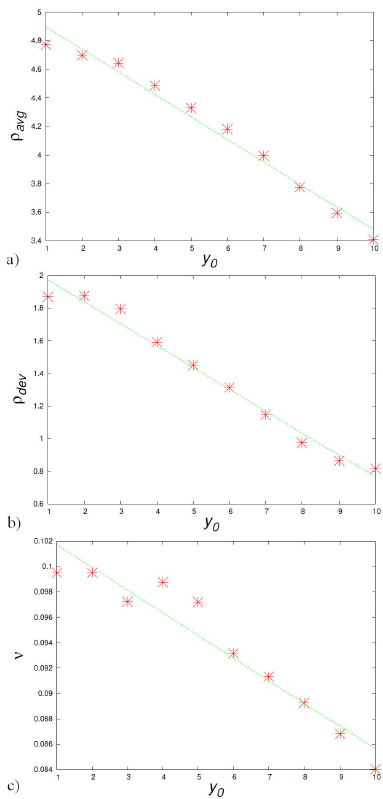
Figure 5 For the case p x0 = 0:1, MR = 1, the stars indicate the average in time of the central density of the final configuration ρ avg , its standard deviation ρdev dev and the peak frequency v for the ten values of y0 used. For each of these quantities we show a linear fit, suggesting the dependency on y0 can be linear.
In structure formation simulations 7,8,12,18,19 the density distributions resulting from the interaction of two or more configurations are associated to density profiles with a solitonic core and a tail, however it is not quite specified whether these are final, relaxed configurations or not. As far as we can tell, the oscillations shown in Fig. 4 do not correspond to a relaxed structure. Even though the density profile can be fitted with the core profile
as indicated in 7,12, where p0 is the central density and rc is a core radius.
The issue is that the density is oscillating with considerable amplitude as seen in Fig. 4. Nevertheless, the fitting was performed on the density profile when the central density is at a local maximum and at a local consecutive minimum. The fitting parameters results appear in Table I for the projection of p along the x-axis. Notice that the central density changes by a factor between two and three from a minimum to a maximum, whereas the core radius changes by nearly 50%. An example of how the density profile changes in time is illustrated in Fig. 6, where the projection of the density along x is shown at two specific times for y0 = 10 at a minimum (t = 254) and at a maximum (t = 261).
Table I Fitting parameters of ρ(x; 0; 0) for the case MR = 1, p x0 = 0:1 and three values of the impact parameter y0.
| y0 | ρ0 | rc | t | comment |
| 1 | 8.280 | 0.647 | 351 | density at a maximum |
| 2.684 | 0.978 | 358 | density at a minimum | |
| 5 | 6.862 | 0.776 | 348 | density at a maximum |
| 2.566 | 0.982 | 355 | density at a minimum | |
| 10 | 5.053 | 0.852 | 254 | density at a maximum |
| 2.571 | 4.023 | 261 | density at a minimum |
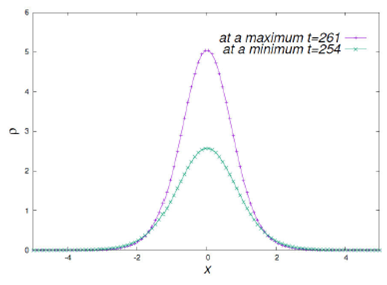
Figure 6 Density profile at two different times for the case p x0 = 0:1, MR = 1 and y0 = 10. The dynamics can be seen in the corresponding animation within supplemental material 32.
In order to have an idea of the physical time scale of these oscillations, we use
the recipe in 12. Considering
a boson mass value 2.5 x 10-22 eV and that core radius of the final
configuration is converging to rc = 1 kpc, using the range of
frequencies
3.4.Unequal mass case
As described before, the case we look at in detail corresponds to MR = 0.5. The time dependence of M, Q and Lz appears in Fig. 2. General properties are very similar to those of the equal mass case. The loss of mass and angular momentum is smaller when the impact parameter is bigger.
Snapshots of the unequal mass MR = 0.5 merger with y0 = 7 are presented in Fig. 7. The resulting high density region wobbles around the origin due to the asymmetric distribution of matter and at some point evolves toward the coordinate origin. Animations for other values of the parameters are also shown in the supplemental material 32.
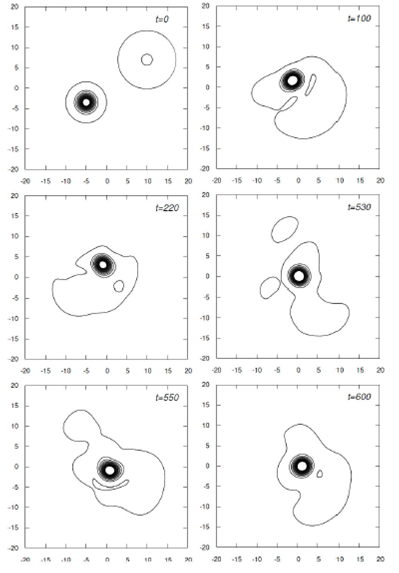
Figure 7 Density isocontours on the xy-plane for the collision for MR = 0:5 with p x0 = 0:1 and y0 = 7.
What is different from the equal mass case is the relaxation process. The
evolution of Q = 2K + W and the central value of the density are shown in Fig. 8 for the two extreme values of the
impact parameter y0 =1,10. The value of Q oscillates around zero with
amplitude an order of magnitude smaller than in the equal mass case. For
density, on the other hand, since the configuration is wobbling around the
coordinate origin, instead of tracking the central value of the density we track
its maximum value
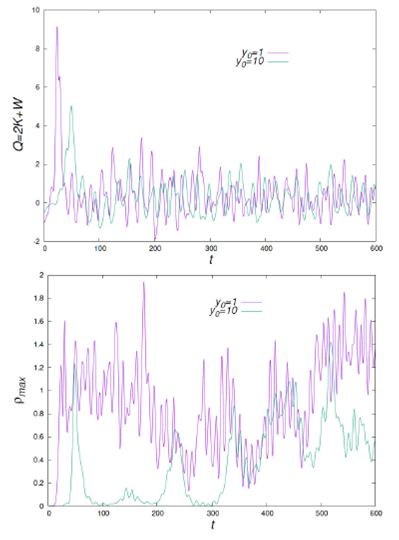
Figure 8 For the case p x0 = 0:1 and MR = 0:5, we show Q = 2K +W and the maximum value of the density as a function of time for the cases y0 = 1 and y0 = 10.
The density does not show any clear sign of relaxation or a particular dominant mode during the time window used in the simulations. This is perhaps a major obstacle when the density is fitted with a space-dependent density fitting function. Unlike the equal mass case, where the average of the density is a good estimate of the asymptotic value, here the expected value of the central density is uncertain. Nevertheless, Fig. 8 indicates that the central density of the final configuration depends on the impact parameter y0.
4.Conclusions and discussion
We have presented the merger process of ultralight bosonic dark matter cores, with detailed illustrations of the equal mass case MR = 1 and a representative unequal mass case MR = 0.5.
In the equal mass case it was found that the final configuration oscillates with amplitudes that depend on the parameters of the binary prior to merger, namely, the mass ratio of the two initial cores, linear momentum and impact parameter. The resulting final configuration was fitted with a solitonic density profile at different times during the relaxation process. It was found that the density may change by factors of nearly three, whereas the core radius can change by nearly 50% percent, and that the amplitude and frequency of the oscillations can be linearly related to the impact parameter of the merger.
In the unequal mass case, due to the size of the initial configurations, the interference becomes important in the symmetry of the final high density zone, which wobbles around the center of mass before it settles toward a nearly fixed location. The density in this case oscillates, however with an irregular superposition of modes, although with values of Q indicating that globally the system evolves around a virialized state.
In both scenarios, it draws attention the fact that the density seems far from a stationary state in cosmological time scales. The reason is that the amplitude of oscillations of the configuration resulting from a merger is not small, and perhaps it would be useful to consider time averages in such fittings.
In order to determine observational restrictions of this dark matter model, it seems unavoidable to systematically analyze the effect of the dynamics of a configuration resulting from a merger on the luminous matter that can be involved in the process. For example their survival questioned for specific scenarios of the head-on case in 15 or restrictions from the existence of star clusters near galactic cores 16.











 nueva página del texto (beta)
nueva página del texto (beta)


